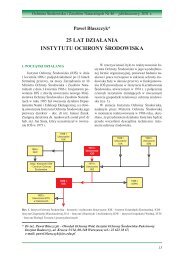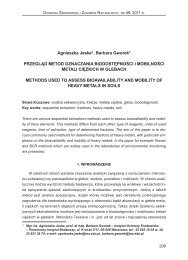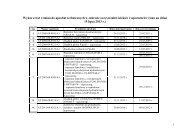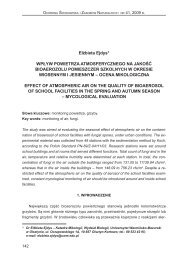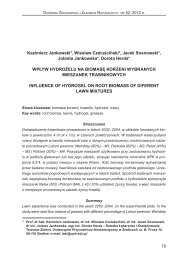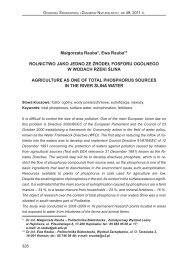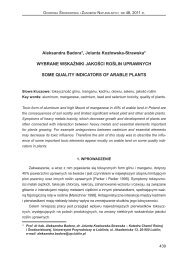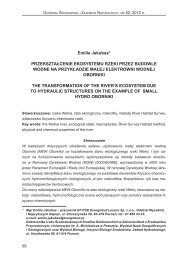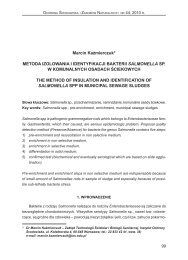Jean B. Diatta*, Ewa ChudziÅska** CHEMICAL REMEDIATION OF ...
Jean B. Diatta*, Ewa ChudziÅska** CHEMICAL REMEDIATION OF ...
Jean B. Diatta*, Ewa ChudziÅska** CHEMICAL REMEDIATION OF ...
Create successful ePaper yourself
Turn your PDF publications into a flip-book with our unique Google optimized e-Paper software.
Ochrona Środowiska i Zasobów Naturalnych nr 41, 2009 r.<br />
<strong>Jean</strong> B. <strong>Diatta*</strong>, <strong>Ewa</strong> Chudzińska**<br />
<strong>CHEMICAL</strong> <strong>REMEDIATION</strong> <strong>OF</strong> ZINC CONTAMINATED SOILS BY<br />
APPLYING A CEMENT-BROWN COAL-BASED COMPONENT<br />
(CEMBRO)<br />
CHEMICZNA REMEDIACJA GLEB ZANIECZYSZCZONYCH CYNKIEM<br />
PRZEZ ZASTOSOWANIE PREPARATU CEMENT-WĘGIEL BRUNATNY<br />
(CEMBRO)<br />
Słowa kluczowe: chemiczna stabilizacja, cynk, cement, węgiel brunatny, CEMBRO, pojemność<br />
buforowa, zdolność generowania protonów, zdolność retencyjna.<br />
Key words: chemical stabilization, zinc, cement, brown coal, CEMBRO, buffering capacity,<br />
proton generation capacity, retention capacity.<br />
Badania przeprowadzono w celu oceny efektywności cementu (CEM), węgla brunatnego<br />
(BC) oraz preparatu „CEMBRO” w procesie stabilizacji/remediacji gleb zanieczyszczonych<br />
cynkiem. Testowany preparat „CEMBRO” przygotowano w oparciu o cement i węgiel brunatny<br />
przy różnych stosunkach masowych. Do badań użyto gleby silnie skażonej cynkiem przez<br />
działalność huty cynku i ołowiu w Miasteczku Śląskim. Cement, węgiel brunatny i „CEMBRO”<br />
zastosowano w trzech dawkach 0; 0,5; 1,5 i 3,0% po czym obiekty inkubowano przez trzy<br />
miesiące. Efektywność stabilizacji/chemicznej remediacji oszacowano na podstawie:<br />
● ilości ekstrahowanych biodostępnych (0,10 mola NaNO 3<br />
dm -3 = Bio Zn<br />
) i wymiennych<br />
(1 mola CH 3<br />
COONH 4<br />
dm -3 = Ex Zn<br />
) form Zn,<br />
● oceny zmian w kompleksie sorpcyjnym<br />
oraz<br />
● właściwości buforowych gleb.<br />
Wyniki ujawniły, że na obiektach, gdzie zastosowano 100% CEM oraz preparat „CEMBRO”<br />
z większym udziałem CEM, odczyn miał decydujący wpływ na stabilizację Zn. W razie zasto-<br />
* Prof. nadzw. dr hab. <strong>Jean</strong> B. Diatta – Katedra Chemii Rolnej, Uniwersytet Przyrodniczy<br />
w Poznaniu, ul. Wojska Polskiego 71F, 60-625 Poznań; tel.: 61 848 77 83; e-mail:<br />
<strong>Jean</strong>diatta63@yahoo.com;<br />
** Dr <strong>Ewa</strong> Chudzińska – Zakład Genetyki, Uniwersytet im. Adama Mickiewicza w Poznaniu,<br />
ul. Umultowska 89, 61-614, Poznań; tel.: 61 829 58 62; e-mail: evpell@amu.edu.pl<br />
89
<strong>Jean</strong> B. Diatta, <strong>Ewa</strong> Chudzińska<br />
sowania „CEMBRO” z większym udziałem BC i 100% BC, pH odegrało natomiast drugorzędną<br />
rolę w procesie chemicznej remediacji. Geochemiczne reakcje cynku (Zn) i jego potencjalna<br />
labilność oszacowane na podstawie zdolności generowania protonów (α) przez adsorbowane<br />
jony Zn oraz zdolność retencyjną (β) badanych obiektów ujawniły, że dawka 1,5% powinna<br />
być rekomendowana dla składów „CEMBRO” od 30/70 do 20/80, czyli odpowiednio CEM/BC.<br />
1. INTRODUCTION<br />
Soil functions to cycle and supply nutrients as well as water for the production of biomass.<br />
Its quality levels is a multifunctional phenomenon, which serves as one of the most important biogeochemical<br />
regulators of the flow of substances into, through and out of the ecosystem [Snakin<br />
et al. 1996]. Hence the anthropogenic disturbance of soils can lead to critical changes in the biosphere,<br />
which, in the end, may threaten the very existence of human beings [Logan 1990]. The<br />
time-scale as well as the magnitude of chemical degradation of soils were decidedly formulated<br />
by Lal and Stewart [1990], that „…despite its widespread severity and global impact, soil degradation<br />
remains an emotional rhetoric rather than a precise and quantifiable scientific entity”.<br />
Since heavy metals are by essence non-biodegradable, therefore action should be taken<br />
to mitigate their direct bioavailability and transfer to the food chain [Panayotova and Velikov<br />
2002]. The potential risk to the environment may originate from soluble fractions of<br />
heavy metals, basically. The mitigation of their negative effects is undertaken throughout remediation<br />
practices, of which stabilization is currently widely suggested.<br />
Several materials (additives or stabilizers) have been used for the stabilization of heavy<br />
metals, Cu and Zn among others, in contaminated soils [Gupta et al. 2000; Basta and McGowen<br />
2004]. One of the specific challenges still remains the choice of readily available, efficient,<br />
environmentally friendly and inexpensive heavy metal stabilizers, especially for Zn whose<br />
amounts in non-arable soils are the mostly used criterion for their toxicity classification.<br />
Remediation techniques available for sites contaminated by heavy metals and zinc<br />
among others are numerous, but usually based either on extraction or stabilization of contaminants.<br />
Many of these techniques are expensive and also imply degradation of soil structure,<br />
which made them impractical for remediation of large area. Chemical stabilization<br />
[Mench et al. 1998; Vangronsveld and Cunningham 1998; Carlon et al. 2000] is an alternative<br />
method by applying materials, which lower the mobility of zinc as only its soluble fractions<br />
create potential risk to environment [Al-Turki and Helal 2004; Düring et al. 2003].<br />
Bioavailability, mobility and toxicity of Zn strongly depends on its chemical speciation and<br />
soil properties such as pH and cation exchange capacity. By increasing pH or soil binding capacity<br />
Zn is immobilized in soil but the total content is still the same [Buczkowski et al. 2002].<br />
Chemical immobilization based on interaction between soil and amendments, which lead to<br />
acceleration of sorption, precipitation and complexation reactions reducing mobility of heavy<br />
metals [Madejón et al. 2006]. Therefore investigation with interacting organic matter com-<br />
90
Chemical remediation of zinc contaminated soils by applying...<br />
pounds and zinc in soils should pertinently evaluate some Zn threshold values, which may be<br />
indicative of a possible negative or positive reaction of soil microorganisms to Zn in the soil<br />
solution. Therefore the transfer of zinc from the soils into plant may be related to its dynamics<br />
as affected by the types and amounts of organic sorbents [Bolan et al. 2004].<br />
The aim of the work was to evaluate the efficiency of a cement-brown coal based component<br />
(CEMBRO) for zinc stabilization in a soil contaminated by a Zn-Pb smelter activity.<br />
The specific purpose was to exhibit the impact of chemical changes as well as those dealing<br />
with soils buffering capacities on Zn chemical stabilization and the resulting significance<br />
for site revitalization.<br />
2. MATERIALS AND METHODS<br />
2.1. Location of the soil sampling<br />
The sampling area lies within the impact zone of the Miasteczko Slaskie Zinc Smelter,<br />
(N 51 o 41’03’’ and E 15 o 57’12’’, Poland) whose activity started since 1966. This zone is surrounded<br />
in the north, west and east by a large Lubliniec Forest complex, and in the southeast<br />
by the localities of Zyglin and Zygliniec, quarters of the Miasteczko Slaskie. A population<br />
of pine as part of artificial restoration, mainly of mixed forest, sporadically mixed wood<br />
grows in the impact zone.<br />
2.2. Physical and chemical analysis<br />
Ten soil samples were collected randomly at the depth 0–30 cm and mixed thoroughly<br />
to form the representative soil sample used for the current study. Prior to physical<br />
and chemical analysis the soil was air-dried and sieved through a 2.0 mm polyethylene<br />
sieve. Granulometric composition was determined by the areometric method,<br />
whereas organic carbon (C org.<br />
) by the Tiurin method as reported by Mocek et al. [2001].<br />
Soil pH at soil/solution ratio of 1:5 (0.010 mole CaCl 2<br />
) was determined potentiometrically<br />
using a pH-meter [Polish Standard, 1994], and the electrical conductivity (EC)<br />
was assayed in water extracts according to Rhoades [1996]. The effective cation exchange<br />
capacity (CEC e<br />
) was obtained by summation of 1 mole KCl·dm -3 extractable<br />
acidity (EA) and exchangeable alkaline cations (Ca 2+ , Mg 2+ , Na +·and K + ) extracted by<br />
1 mole CH 3<br />
COONH 4·dm -3 (pH 7.0) as described by Thomas [1982]. Acid soluble forms<br />
of Zn were extracted by using 1 mole HCl·dm -3 [Kashem et al., 2007], whereas bioavailable<br />
forms were assayed by 0.10 mole NaNO 3·dm -3 [Gupta, Hani 1989]. The choice of<br />
the 1 mole HCl·dm -3 was attributed to the fact, that soils within the investigated area are<br />
basically sandy. Therefore amounts of metal determined by this chemical test are suggested<br />
to be designated as pseudo-total. All performed chemical tests were run in du-<br />
91
<strong>Jean</strong> B. Diatta, <strong>Ewa</strong> Chudzińska<br />
plication and metals as well as other elements were determined by the FAAS method<br />
(Flame Atomic Absorption Spectrophotometry, Varian 250 plus).<br />
2.3. Cement (CEM) and Brown Coal (BC) chemical composition and CEMBRO<br />
characteristics<br />
Portland cement is a popular material used in for building. Its consists of grinded clinker<br />
(50–65% 3CaO·SiO 2<br />
; 20% 2CaO·SiO 2<br />
; 10% 4Ca·Al 2<br />
O 3·Fe 2<br />
O 3<br />
; 10% 3CaO·Al 2<br />
O 3<br />
), [Neville<br />
1977] and gypsum. Due to the high content of calcium oxides, once introduced into the soil,<br />
it raises soil pH which acts as heavy metals immobilizing factor. Furthermore the aluminum,<br />
iron and silicon compounds enhances the potential capacity for metals sorbing. Brown coal<br />
used in this study came from Konin brown coal basin (Poland). The chemical compositions<br />
of both materials used as stabilizers are listed in Tables 1 and 2.<br />
Table 1. Chemical composition of Portland cement<br />
Tabela 1. Chemiczne właściwości cementu typu Portland<br />
Cement<br />
(CEM)<br />
pH CaO SiO 2 Al 2 O 3 Fe 2 O 3 Zn<br />
(H 2<br />
O)<br />
% mg·kg -1<br />
13.10 64.50 21.97 4.75 2.20 18.66<br />
Table 2. Chemical properties of brown coal<br />
Tabela 2. Chemiczne właściwości węgla brunatnego<br />
Brown coal<br />
(BC)<br />
pH C org N tot Zn<br />
C : N<br />
(H 2<br />
O)<br />
g·kg -1<br />
mg·kg -1<br />
6.28 448 3.7 121:1 0.15<br />
The cement-brown coal based component namely CEMBRO was obtained by properly<br />
mixing cement and brown coal at different ratios as shown below (Tab. 3):<br />
Table 3. CEMBRO component at different cement (CEM) to brown coal (BC) ratios<br />
Tabela 3. Preparat CEMBRO przy różnych stosunkach cementu (CEM) do węgla brunatnego (BC)<br />
Cement CEM (%) CEMBRO component Brown coal BC (%)<br />
100 A – 0<br />
90 B 90 / 10 10<br />
80 C 80 / 20 20<br />
60 D 60 / 40 40<br />
50 E 50 / 50 50<br />
40 F 40 / 60 60<br />
30 G 30 / 70 70<br />
20 H 20 / 80 80<br />
10 I 10 / 90 90<br />
0 J – 100<br />
92
Chemical remediation of zinc contaminated soils by applying...<br />
2.4. Experimental design and incubation process<br />
CEMBRO was added to 1.0 kg of Zn contaminated soil at the rates 0, 0.5, 1.5 and 3.0%<br />
(dry weight basis). The same applied for cement alone (CEM) as well as brown coal (BC),<br />
which were also incorporated at rates as reported above. All treatments were three times<br />
replicated, kept moist at 75% FWHC (Field water holding capacity) and incubated for 14<br />
weeks at 18±2 o C. Soil samples collected at the end of the incubation period were chemically<br />
analysed as described in the sub-section „Physical and chemical analysis”.<br />
Computations and statistical evaluations were made by using the Statgraphics ® software<br />
and Excel ® sheet facilities.<br />
3. RESULTS AND DISCUSSION<br />
3.1. CEMBRO-induced pH and organic carbon changes<br />
The investigated soil is typically sandy and characterized by a low content of organic<br />
carbon (7.3 g·kg -1 ) as reported in Table 4. These properties along with soil pH were the core<br />
for exhibiting significantly low both exchangeable calcium as well as cation exchange capacity<br />
(CEC). Moreover the acidic nature of the soil environment may have been one of the<br />
limiting factors affecting grasses and shrubs growth.<br />
Table 4. Physical and chemical characteristics of the investigated soil<br />
Tabela 4. Fizyczne i chemiczne właściwości badanej gleby<br />
Sand<br />
(2.0–0.02 mm)<br />
Silt<br />
(0.02–0.002 mm)<br />
Clay<br />
<strong>Jean</strong> B. Diatta, <strong>Ewa</strong> Chudzińska<br />
component consisting of 50% CEM and 50% BC, it comes out, that pH at the 60/40 as well as<br />
40/60 ratios was kept quite unchanged and depended solely on the rates of applied CEMBRO.<br />
This finding is of crucial value in terms of economical planning in one hand and environmental<br />
remediation on the other hand, since it allows a flexible handling of cement and brown coal.<br />
Fig. 1. Effect of CEMBRO application on pH and organic carbon status of soils (A, B……J, see<br />
Tab. 3)<br />
Rys. 2. Wpływ preparatu CEMBRO na pH i zawartość węgla organicznego w glebach (A, B……J,<br />
patrz tab. 3)<br />
The content of organic matter increased progressively along with CEMBRO rates, being<br />
higher in the case of 3.0%. It should be mentioned that chemically, brown coal is mostly inactive<br />
and its breakdown will proceed slowly due to the wide C:N ratio (121:1). Based on this sole<br />
characteristics, the formation of organic acid-sand conglomerates seems practically and hardly<br />
expectable. Therefore the addition of cement was intended to boost the emergence of functional<br />
groups via enhancing the dissolution of fulvic acids, which exhibit significant affinity for metal retention,<br />
Zn among others [Días-Barrientos et al. 2003]. In other words CEMBRO will provide the<br />
soil environment with appropriate amounts of Ca (64.50% CaO in CEM) to raise the extremely<br />
low Ca level, Si (21.97% SiO 2<br />
in CEM) as a binding-stabilizing agents, and brown coal (44.8%<br />
C org<br />
in BC) as whole „sticking” material as below. Such physical and chemical future of CEMBRO<br />
is not limited to the improvement of the soil structure (conglomerate formation), only, but also as<br />
Zn stabilizing tool, since its levels were very high to exhibit biological (bio) and (phyto)toxicity.<br />
3.2. CEMBRO-aided Zn stabilization: Efficiency and perspectives<br />
The susceptibility of the investigated soil ecosystem to degradation is limited not only<br />
to the exceptionally low levels of both organic matter and calcium, but to very high levels of<br />
acid-soluble (AS Zn<br />
), exchangeable (Ex Zn<br />
) and even bioavailable (Bio Zn<br />
) Zn forms (Tab. 5).<br />
This is of great environmental, due to the fact that Ex Zn<br />
and Bio Zn<br />
fractions which generally<br />
exhibit direct impact on living organisms (i.e., microorganisms and plants), [Smolders 2005],<br />
94
Chemical remediation of zinc contaminated soils by applying...<br />
represent ca 49 and 10%, respectively as compared to AS Zn<br />
. The sandy character of the degraded<br />
soil along with the substantially low organic matter content were fully responsible for<br />
the high lability of Zn as reported by Kabata-Pendias [1993].<br />
Table 5. Acid soluble, exchangeable and bioavailable forms of Zn extracted from the soil<br />
Tabela 5. Wymienne, biodostępne oraz rozpuszczalne w kwasie formy Zn ekstrahowane z badanej<br />
gleby<br />
1 mole HCl<br />
Acid soluble (AS Zn<br />
)<br />
1 mole CH 3<br />
COONH 4<br />
Exchangeable (Ex Zn<br />
)<br />
0.1 mole NaNO 3<br />
Bioavailable (Bio Zn<br />
)<br />
Zn (mg·kg -1 )<br />
405.7 197.8 38.3<br />
The specific aim of CEMBRO application was targeted for stabilizing Zn in order to create<br />
appropriate soil conditions for further vegetation establishment. The latter one may potentially<br />
take place under significantly reduced Zn solution concentrations. The overview of<br />
the efficiency course at particular CEMBRO rates is reported on the Figure 2.<br />
Fig. 2. Zinc stabilization efficiency estimated throughout Ex Zn<br />
and Bio Zn<br />
fractions at given CEMBRO<br />
rates (A, B……J, see Tab. 3)<br />
Rys. 2. Skuteczność stabilizacji cynku oszacowana poprzez frakcje Ex Zn<br />
i Bio Zn<br />
dla wybranych<br />
dawek CEMBRO (A, B……J, patrz tab. 3)<br />
Organic matter incorporated into soils contain organic compounds of different molecular<br />
weight and capacity for forming stable complexes with metallic cations (Zn among others) in<br />
solution. These compounds are characterized by one or more functional groups (carboxylic<br />
– COOH, phenolic – OH, and others), that exhibit negative charges, when fully dissociated<br />
[Sparks 1995]. This process may be strengthened by the raise of pH induced by the presence<br />
of cement which in turn increases the surface charge of organo-mineral colloids via deprotonation<br />
reactions [Davranche et al. 2003]. Such chemical reactions consequently lead to<br />
95
<strong>Jean</strong> B. Diatta, <strong>Ewa</strong> Chudzińska<br />
a significant decrease of Zn in the ambient soil solution and favor its simultaneous mitigation<br />
[Dias et al. 2003]. The joint effect of CEMBRO components and the resulting Zn stabilization<br />
efficiency are listed in Table 6a and Table 6b for the most efficient ratio ranges only.<br />
Table 6a. Zinc stabilization efficiency evaluated for exchangeable (Ex Zn<br />
) Zn forms<br />
Tabela 6a. Skuteczność stabilizacji cynku oceniona dla form Zn wymiennego (Ex Zn<br />
)<br />
CEMBRO rates<br />
(%)<br />
Ex Zn<br />
(mean ±SD)<br />
Whole range (A…..J)<br />
Efficient ratio range<br />
(ERR)<br />
Stabilization<br />
Efficiency (%) *<br />
0.5 58.7 ± 8.7 A….F 70.3<br />
1.5 30.7 ± 4.1 A….G 84.5<br />
3.0 27.2 ± 3.5 A….H 86.3<br />
* (Ex Zn<br />
before stabilization - Ex Zn<br />
after stabilization)·100<br />
Ex Zn<br />
before stabilization<br />
Table 6b. Zinc stabilization efficiency evaluated for bioavailable (Bio Zn<br />
) Zn forms<br />
Tabela 6b. Skuteczność stabilizacji cynku oceniona dla form Zn biodostępnego (Bio Zn<br />
)<br />
Bio Zn<br />
(mean ±SD)<br />
Whole range (A…..J)<br />
Efficient ratio range<br />
(ERR)<br />
0.5 0.75 ± 0.67 A…...F 98.0<br />
1.5 0.16 ± 0.11 A……H 99.6<br />
3.0 0.13 ± 0.17 A……I 99.7<br />
CEMBRO rates<br />
(%)<br />
* (BioZn before stabilization - Bio Zn<br />
after stabilization)·100<br />
Bio Zn<br />
before stabilization<br />
Stabilization<br />
Efficiency (%) *<br />
The environmental friendly CEMBRO rate, which could be suggested as applicable and<br />
sufficiently efficient for Zn stabilization depended on the chemical test (Ex Zn<br />
, or Bio Zn<br />
) used<br />
for stabilization evaluation. Data reported on Fig. 2 and outcome to Tables 6a and 6b, clearly<br />
show, that all CEMBRO ratios were efficient up to 30/70 (namely G), mainly for the rates<br />
1.5 and 3.0%. The lowest rate, i.e., 0.5% has proved relatively less efficient for the Ex Zn<br />
assessment<br />
as compared to Bio Zn<br />
forms. Therefore based on these efficiency levels the rate<br />
1.5% should be recommended for the following CEMBRO ratios: 30/70 and 20/80 (Tab. 3).<br />
In perspectives the ratios from 1:2.5 up to 1:4 (i.e., CEM:BC) appeared to be ecologically<br />
efficient and safe for the investigated soil.<br />
3.3. Geochemical reactions and Zn potential lability<br />
Zinc stabilization as related to CEMBRO incorporation into the soils proceeded simultaneously<br />
throughout geochemical changes, among others the cation exchange capacity<br />
(CEC). The gradual decrease of soils capacity for Zn retention was reverse to brown coal<br />
96
Chemical remediation of zinc contaminated soils by applying...<br />
inputs. It means the higher the share of BC in CEMBRO, the relatively lowest the CEC of<br />
the soil (Fig. 3).<br />
The analysis of data reported in the Fig. 3 implies, that zinc release to the ambient soil<br />
solution appeared to be closely related more to increasing BC rates than CEM. It has been<br />
reported [McBride 1989; McBride et al. 1997b], that metal reactions (zinc among others) with<br />
soil colloids proceeds through deprotonation reactions, which in turn tend to increase metal<br />
activity in the soil solution due to H + - based secondary acidification. These conditions are expected<br />
under current investigations since brown coal may decidedly favor such processes.<br />
The evaluation of this process was performed via proton generation capacity (α) of Zn adsorbed<br />
and the retention power (β) of the soils. These values were obtained from linear coefficients:<br />
y = αx ± β, where: y = K d<br />
(partition coefficient); x = pH CaCl2<br />
. Results are listed in Table 7.<br />
Fig. 3. Changes in the cation exchange capacity (CEC) of soils as induced by CEMBRO incorporation<br />
(A, B……..J, see Tab. 3).<br />
Rys. 3. Zmiany w kationowej pojemności wymiennej (CEC) gleb pod wpływem CEMBRO<br />
(A, B……..J, patrz tab. 3)<br />
The capacity of proton generation as induced by Zn adsorption decreases with increasing<br />
the share of BC in CEMBRO. This was attributed to the acidifying character of BC (Fig.<br />
1), hence zinc ions were sufficiently active in the soil solution without a need for reacting<br />
with functional groups (deprotonation). Relationships between partition coefficients and soil<br />
pH yielded stronger coefficients of determination (R 2 ) at the lowest CEMBRO rates (i.e.,<br />
0.5%) as compared to the highest ones. This may be related to the emergence of great heterogeneity<br />
of Zn binding surfaces as a result of interacting high amounts of CEM with BC.<br />
On the other hand the power of soils for generating negative charges increased along with<br />
BC rates. Similar findings were reported by [Harter and Naidu 1995; Kumpiene 2003], who<br />
stated about the geochemical property of organic matter as a potential „reservoir” of func-<br />
97
<strong>Jean</strong> B. Diatta, <strong>Ewa</strong> Chudzińska<br />
tional groups, i.e., negative charges. In fact the apparently high α values with simultaneously<br />
low β are indicative of weaker Zn retention properties of soils. Furthermore high solution<br />
concentrations of H + directly interferes with Zn ions and reduces their attraction by soil colloids.<br />
This is less probable at higher CEMBRO rates. These results support fully the view<br />
mentioned above on the rate 1.5% to be recommended for the following CEMBRO ratio<br />
ranges: from 30/70 to 20/80, i.e., namely CEM/BC, respectively.<br />
Table 7. Proton generation capacity (α) and soil retention power (β) for Zn estimated for bioavailable<br />
(Bio Zn<br />
) and exchangeable (Ex Zn<br />
) forms<br />
Tabela 7. Zdolność generowania protonów (α) oraz zdolność zatrzymywania (β) obliczone dla<br />
form Zn biodostępnego (Bio Zn<br />
) i wymiennego (Ex Zn<br />
)<br />
Chemical<br />
test<br />
%<br />
α<br />
mole protons / mole Zn sorbed<br />
β<br />
mole of negative charges / mole<br />
Zn sorbed<br />
R 2<br />
0.5 1.23 -4.71 0.83<br />
a<br />
Kd [dm 3·kg-1 ]<br />
for 1.5 1.18 -4.66 0.79<br />
3.0 0.96 -2.71 0.70<br />
for<br />
Ex Zn<br />
1.5 0.30 0.09 0.76<br />
0.5 0.27 -0.01 0.85<br />
b<br />
Kd [dm 3 ·kg -1 ]<br />
3.0 0.19 0.77 0.53<br />
a<br />
mg Zn kg –1 in 1 mole HCl ; b mg Zn kg –1 in 1 mole HCl<br />
mg Zn dm –3 in 0.1 mole NaNO 3<br />
mg Zn dm –3 in 0.1 mole CH 3<br />
COONH 4<br />
4. CONCLUSIONS<br />
1. The investigated soil is typically sandy and characterized by a low content of organic<br />
carbon. Moreover the acidic nature of the soil environment is one of the factors affecting<br />
grasses and plant growth.<br />
2. The acid soluble Zn fraction amounted to 405.7 mg·kg -1 of which ca 49 and 10% were<br />
represented by exchangeable and bioavailable Zn forms, respectively. This is of great<br />
environmental concern due to the fact that these fractions will exert direct impact on living<br />
organisms.<br />
98
Chemical remediation of zinc contaminated soils by applying...<br />
3. The incorporation of cement alone to the sandy soil has led to a significant rise of the<br />
soil pH (up to 8), whereas the application of brown coal alone did not exert any marked<br />
influence on soil pH. The component „CEMBRO” has displayed a greater stabilization<br />
efficiency for Zn in treatments with a higher share of cement.<br />
4. Geochemical reactions of Zn and its potential lability assessed on the basis of proton<br />
gene ration capacity (α) of sorbed Zn and the retention power (β) of soils revealed that<br />
the rate 1.5% should be recommended for the following „CEMBRO” ratio ranges: from<br />
30/70 to 20/80, i.e., namely CEM/BC, respectively.<br />
The realization of investigations was possible owing to the financing support from<br />
means allocated to the Science for years 2006–2009; Research Project No. 2 P06<br />
L 02430: „Analysis of the process of differentiation of a pine (Pinus sylvestris L.)<br />
population gene pool as a result of environmental stress induced by industrial<br />
contaminants”.<br />
REFERENCES<br />
AL-TURKI A.I., HELAL M.I.D. 2004. Mobilization of Pb, Zn, Cu and Cd in polluted soil. Pakistan<br />
Journal of Biological Sciences 7(1): 1972–1980.<br />
BASTA N.T., MCGOWEN S.L. 2004. Evaluation of chemical immobilization treatments for<br />
reducing heavy metal transport in a smelter-contaminated soil. Environmental Pollution<br />
127: 3–82.<br />
BOLAN N.S., ADRIANO D.C., DE-LA-LUZ M. 2004. Dynamics and environmental signifi-<br />
cance of dissolved organic matter in soil. In. SuperSoil 2004. 3 rd Australian New Zealand<br />
Soils Conference, 5–9 December, 2004. (www.regional.org.au/au/asssi/).<br />
BUCZKOWSKI R., KONDZIELSKI I., SZYMAŃSKI T. 2002. Metody remediacji gleb zanieczyszczonych<br />
metalami ciężkimi. Wydawnictwo Uniwersytetu Mikołaja Kopernika w Toruniu:<br />
60–63.<br />
CARLON C., NORBIATO M., CRITTO A., MARCOMINI A. 2000. Risk analysis applied to<br />
a contaminated industrial site: Determination of risk based remedial targets. Annale<br />
Chimica 90: 349–358.<br />
DAVRANCHE M., BEAUFRETON S., BOLLINGER J.C. 2003. Influence of carbonates on<br />
the surface charge of a natural solid. Journal of Colloid Interface Science 249:113–118.<br />
DÍAS-BARRIENTOS E., MADRID L., MAQUEDA C., MORILLO E. RUIZ-CORTES E., BA-<br />
SALLOTE E., CARRILLO M. 2003. Copper and zinc retention by an organically amended<br />
soil. Chemosphere 50: 911–917.<br />
DÍAS A.C.B., PANAN M.A., MIYAZAWA M., CARLOS Z. 2003. Plant residues: short term<br />
effect on sulphate, borate, zinc and copper adsorption by an acid oxisol. Brazilian Archives<br />
of Biology and Technology 46(2): 199–202.<br />
99
<strong>Jean</strong> B. Diatta, <strong>Ewa</strong> Chudzińska<br />
DÜRING R.A., HOSS T., GÄTH S. 2003. Sorption and bioavailability of heavy metals in longterm<br />
differently tilled soils amended with organic wastes. Science of the Total Environment<br />
313: 227–234.<br />
GUPTA S.K., HANI H. 1989. Méthode pour la détermination dans les sols les concentrations<br />
de métaux lourds disponibles pour les plantes et les microorganismes et vérification<br />
dans les zones contaminées, Rapport final COST 681, Nr 2. (FAC).<br />
GUPTA S.K., HERREN T., WENGER K., KREBS R., HARI T. 2000. In Situ Gentle Remediation<br />
Measures for Heavy Metal-Polluted Soils. Phytoremediation of Contaminated Soil<br />
and Water. Poll. 303–322. CRC Press LLC.<br />
HARTER R.D., NAIDU R. 1995. Role of metal-organic complexation in metal sorption by soils.<br />
Advances in Agronomy 5: 219–265.<br />
KABATA-PENDIAS A.1993. Behavioural properties of trace metals in soils. Applied Geochemistry,<br />
Suppl. Issue 2: 3–9.<br />
KASHEM M.A., SINGH B.R., KONDO T., IMAMUL HUQ S.M., KAWAI S. 2007. Comparison<br />
of extractability of Cd, Cu, Pb and Zn with sequential extraction in contaminated and<br />
noncontaminated soils. International Journal of Environmental Science and Technology<br />
4(2): 169–176.<br />
KUMPIENE J. 2003. Role of organic matter in the immobilization of metals. Licentiate Thesis.<br />
Lulea University of Technology, Sweden.<br />
LAL R., STEWART B.A. 1990. Soil degradation. In Stewart V.A. (Editor), Adv. Soil Sci. Vol.<br />
11, Springer-Verlag: 345.<br />
LOGAN T.J. 1990. Chemical degradation of soil. Advances in Soil Science 11: 187–219.<br />
MADEJÓN E., PĖREZ DE MORA A., FELIPE E., BURGOS P., CABRERA F. 2006. Soil<br />
amendments reduce trace element solubility in a contaminated soil and allow regrowth<br />
of nature vegetation. Environmental Pollution 139: 40–52.<br />
MCBRIDE M. B. 1989. Reactions controlling heavy metal solubility in soils. Advances in Soil<br />
Science 10: 1–56.<br />
MCBRIDE M. B., SAUVÉ S., HENDERSHOT W. 1997b. Solubility control of Cu, Zn, Cd and<br />
Pb in contaminated soils. European Journal of Soil Science 48: 337–346.<br />
MENCH M., VANGROSVELD J., LEPP M.W., EDWARDS R. 1998. Metal-Contaminated<br />
Solis: In Situ Inactivation and Phytorestoration. Physico-chemical Aspects and Efficiency<br />
of Trace Element Immobilization by Soil Amendments. R. G. Landes Company:<br />
151–179.<br />
MOCEK A., DRZYMAŁA S., MASZNER P. 2000. Geneza, Analiza i Klasyfikacja Gleb. 2000.<br />
Wyd. AR, Poznań.<br />
NEVILLE A.M. 1977. Właściwości betonu [Properties of concrete]. Arkady, Warszawa 17–21.<br />
PANAYOTOVA M. and VELIKOV B. 2002. Kinetics of heavy metal ions removal by use of<br />
natural Zeolite. Jour. Environ. Sci. Health (Part A) 37(2): 139–147.<br />
100
Chemical remediation of zinc contaminated soils by applying...<br />
RHOADES J.D. 1996. Salinity: Electrical conductivity and total dissolved solids. In: Sparks<br />
D.L. et al. (ed). Methods of soil analysis. Part 3. SSSA Book Ser. 5. SSSA, Madison,<br />
WI: 417–435.<br />
SNAKIN V.V., KRECHETOV P.P., KUZOVNIKOVA T.A., ALYABINA I.O, GUROV A.F, STE-<br />
PICHEV A.V. 1996. The system of assessment of soil degradation. Soil Technology 8:<br />
331–343.<br />
SMOLDERS E. 2005. Ecotoxicity of heavy metals in soils. Katholieke Universiteit Leuven,<br />
Belgium (www.proland.iung.pulawy.pl/materials/wp2/day_1/07_pulawy2005).<br />
Soil quality and pH determination. 1994. First edition (in Polish). Polish Standard, Polish<br />
Standardisation Committee. ref. PrPN-ISO 10390.<br />
SPARKS D.L. 1995. Environmental soil chemistry. “Chemistry of soil organic matter”: 53–<br />
80. Academic Press Inc., San Diego, California.<br />
THOMAS G.W. 1982. Exchangeable cations. Methods of Soil Analysis, Part 2. Chemical<br />
and Microbial Properties (No. 9), ASA-SSSA. Second Edition, Edited by Page A.L., Miller<br />
R.H. and Keeney D.R. Madison Wisconsin USA: 159–165.<br />
VANGRONSVELD J.C.H.M., CUNNINGHAM S.D. 1998. Metal-Contaminated Soils: In Situ<br />
Inactivation and Phytorestoration. R.G. Landes Company: 1–15.<br />
101



